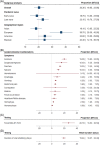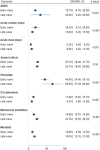Gastroenterology manifestations and COVID-19 outcomes: A meta-analysis of 25,252 cohorts among the first and second waves
- PMID: 33527440
- PMCID: PMC8014082
- DOI: 10.1002/jmv.26836
Gastroenterology manifestations and COVID-19 outcomes: A meta-analysis of 25,252 cohorts among the first and second waves
Abstract
A meta-analysis was performed to identify patients with coronavirus disease 2019 (COVID-19) presenting with gastrointestinal (GI) symptoms during the first and second pandemic waves and investigate their association with the disease outcomes. A systematic search in PubMed, Scopus, Web of Science, ScienceDirect, and EMBASE was performed up to July 25, 2020. The pooled prevalence of the GI presentations was estimated using the random-effects model. Pairwise comparison for the outcomes was performed according to the GI manifestations' presentation and the pandemic wave of infection. Data were reported as relative risk (RR), or odds ratio and 95% confidence interval. Of 125 articles with 25,252 patients, 20.3% presented with GI manifestations. Anorexia (19.9%), dysgeusia/ageusia (15.4%), diarrhea (13.2%), nausea (10.3%), and hematemesis (9.1%) were the most common. About 26.7% had confirmed positive fecal RNA, with persistent viral shedding for an average time of 19.2 days before being negative. Patients presenting with GI symptoms on admission showed a higher risk of complications, including acute respiratory distress syndrome (RR = 8.16), acute cardiac injury (RR = 5.36), and acute kidney injury (RR = 5.52), intensive care unit (ICU) admission (RR = 2.56), and mortality (RR = 2.01). Although not reach significant levels, subgroup-analysis revealed that affected cohorts in the first wave had a higher risk of being hospitalized, ventilated, ICU admitted, and expired. This meta-analysis suggests an association between GI symptoms in COVID-19 patients and unfavorable outcomes. The analysis also showed improved overall outcomes for COVID-19 patients during the second wave compared to the first wave of the outbreak.
Keywords: COVID-19; GIT; SARS-CoV-2; meta-analysis; pandemic.
© 2021 Wiley Periodicals LLC.
Conflict of interest statement
The authors declare that there are no conflict of interests.
Figures




References
-
- Wong SH, Lui RNS, Sung JJY. Covid‐19 and the digestive system. J Gastroenterol Hepatol. 2020;35(5):744‐748. - PubMed
-
- Goh KJ, Kalimuddin S, Chan KS. Rapid progression to acute respiratory distress syndrome: review of current understanding of critical illness from coronavirus disease 2019 (COVID‐19) infection. Ann Acad Med Singapore. 2020;49:108‐118. - PubMed
Publication types
MeSH terms
LinkOut - more resources
Full Text Sources
Other Literature Sources
Medical
Miscellaneous

